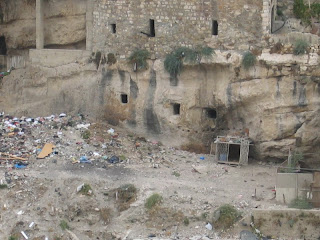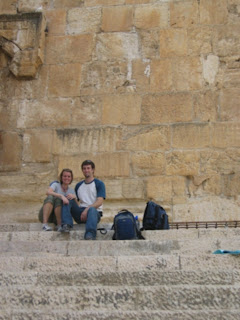


The first picture is of bedrock. It’s hard without people in the picture to give it size but the building on top is a house. The holes in it are very very old tombs. More on bedrock later.
The second picture is what they think Jerusalem looked like during the time of David. Today it would cover every hill you see in this picture and then some.
The last picture is of Bryan and me on the Temple Steps. They have been redone but these are where the steps were leading into the Temple during the time of Jesus. The wall behind us is a wall for the platform on which the Temple once stood. No wall for the Temple now remains that we can see.
Yesterday was our first big field study. Jerusalem University College (henceforth JUC) does NOT do tours. J JUC does field studies. You study in the classroom, prepare for the trip, and then walk for hours through different locations studying more than just what you can see. They want to bring together many different fields of study to your interaction with the land of Israel. They discuss the history (Biblical and secular) of a certain location- what we know happened here (which is a lot). They discuss the geography of the location- what’s the terrain, the shape of the land, natural resources available… They discuss the archaeology of the location- Israel is one of the oldest places of habitation- there is a TON of archaeology to be studied and that already has been studied here. (Anything after the 1700’s is considered ‘modern.’) They discuss the culture of the different periods that come to play in the history. They even discuss, at times, the modern situation and how history is either repeating itself, or explaining itself.
I know it may not sound the most exciting, but to be honest, Bryan and I really enjoy it. It’s amazing what you learn about the Bible.
The trip yesterday was spent walking around the areas of Jerusalem that existed during Biblical times. Those from flat areas may not fully be able to appreciate the terrain in Jerusalem (or Israel for that matter). At one time it was a ‘city on a hill,’ now it is a city set on a several different hills and we climbed a few of them yesterday. Not big mountains, but we walked a lot of up and down terrain. In the morning we did the Old Testament city and in the afternoon we did the New Testament city. Same basic area but the city grew on the north and west sides by the time of the New Testament.
How can one city take all day to study (it could take numerous days but they only use one)? Quick history lesson here- according to the Bible when David became king of all Israel he decided to take the city of Jerusalem and make it his capitol. That occurred around the time of 1030 BC- so over 1000 years before the time of Jesus and over 3000 years before our time. Anyway, over 3000 years ago David made Jerusalem the capital of Israel. By that time the city was already over 2000 years old!!!! Jerusalem has a bit of a history to it since it is one of the oldest inhabited cities in the world. There’s a lot to see and discuss.
One quick Bible lessons. Scripture talks about God being our rock. The word used there is actually referring not to a stone or pebble or even a ‘rock.’ What it’s describing is actually bedrock which can go for miles. It is huge. This bedrock can give everything needed for life. It is foundational and helpful, providing relief and sustenance. That is our God.
Enjoy!
Wow! Your adventure looks and sounds so cool! I look forward to hearing many more stories when you guys get home…we miss you both! Hope all is well!